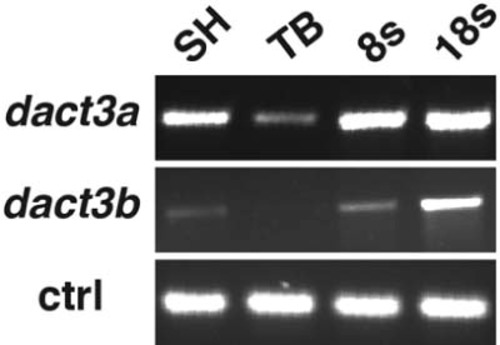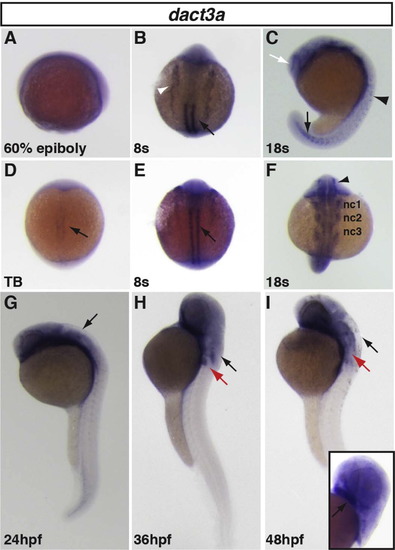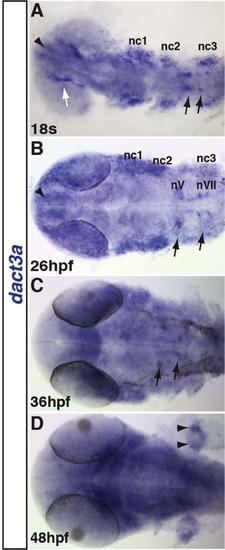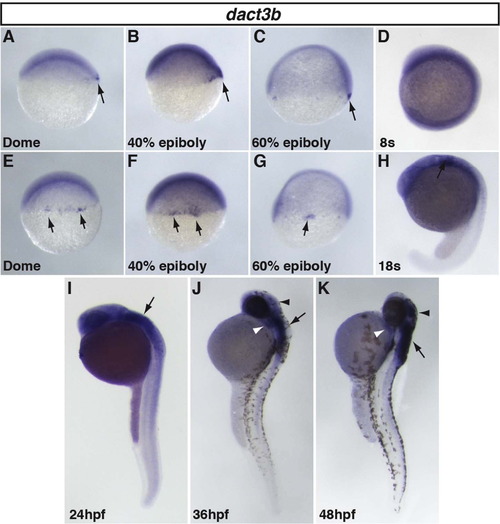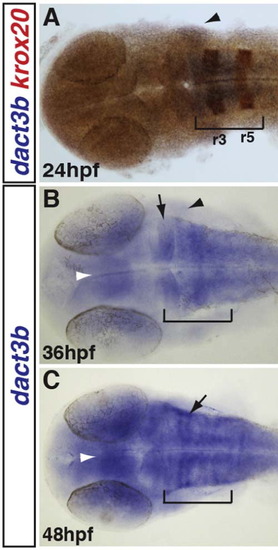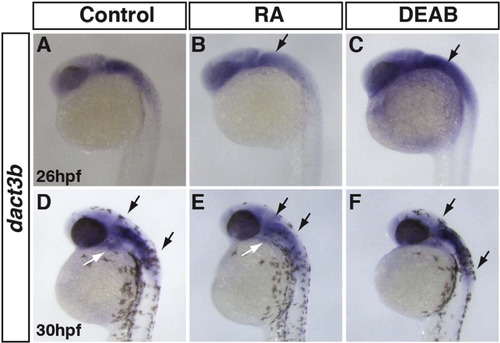- Title
-
Retinoic acid negatively regulates dact3b expression in the hindbrain of zebrafish embryos
- Authors
- Mandal, A., Waxman, J.
- Source
- Full text @ Gene Expr. Patterns
|
RT-PCR analysis of dact3a and dact3b gene expression. Expression of dact3a and dact3b analyzed by RT-PCR at the indicated stages. Solo served as a positive control. EXPRESSION / LABELING:
|
|
Zebrafish dact3a expression from 60% epiboly through 48 hpf. (A) Specific dact3a expression was not observed at 60% epiboly, even though it is detectable by RT-PCR ( Fig. 3). (D) Dact3a expression in the adaxial mesoderm at the TB stage (black arrow). (B,E) Dact3a expression in the somites (black arrows) and anterior lateral plate mesoderm (white arrowhead) at the 8s stage. (C) Expression at the telencephalon (white arrow), spinal cord neurons (black arrowhead), and the forming somites (black arrow) at the 18s stage. (F) Mandibular (nc1), hyoid (nc2), and branchial (nc3) neural crest expression and medial eye expression (black arrowhead) at the 18s stage. (G-I) Hindbrain expression at 24, 36 and 48 hpf (black arrow). At 36 and 48 hpf, dact3a expression is visible in the pectoral fin bud (red arrow). Inset: Cartilage expression (black arrow) at 48 hpf. A, C, G, H, I are lateral views. B, D, E, F are dorsal views. Anterior up in all the images. |
|
Dact3a expression in the brain. (A) Dact3a expression in the telencephalon (black arrowhead), medial eye (white arrow), neural crest (nc1, 2, 3) and hindbrain neurons (black arrows). (B) Expression in the nV (trigeminal) and nVII (facial) cranial branchiomotor neurons (black arrows). (C) Expression in the branchiomotor neurons (black arrows). (D) Pectoral fin bud expression in two distinct domains (black arrowheads). All the images are dorsal with anterior right. EXPRESSION / LABELING:
|
|
Zebrafish dact3b expression from dome through 48 hpf. (A-C, E-G) Dact3b expression in the dorsal blastoderm margin from dome through 60% epiboly stage (black arrow). (D) Specific dact3b is not expressed at the 8s stage, even though we could detect it with RT-PCR ( Fig. 3). (H,I) Dact3b expression in the hindbrain starts at 18s and is maintained through 24 hpf embryos (arrow). (J,K) Dact3b expression initiates in the second pharyngeal arch (white arrowheads) and the dorsal region of the midbrain/tectum (black arrowheads) at 36 hpf and is maintained through 48 hpf. Dact3b continues to be expressed in the hindbrain at 36 and 48 hpf (black arrows). A-D and H-K are lateral views with dorsal rightward. E-G are dorsal views. In all images, anterior is up. EXPRESSION / LABELING:
|
|
Dact3b expression in the hindbrain. (A) Double WISH for dact3b and krox-20 at 24 hpf. Krox-20 (orange) is expressed in r3 and r5. Dact3b expression is from r2 through r6 (brackets). dact3b is expressed in the adjacent second pharyngeal arch (black arrowhead). (B) Dact3b expression extends more anteriorly past the midbrain-hindbrain boundary (black arrow) and is expressed in the tectum by 36 hpf (white arrowhead). Second pharyngeal arch expression is maintained (black arrowhead). (C) By 48 hpf, dact3b expression is increased and is in stripes consistent with anterior branchiomotor neuron expression (black arrow) ( Chandrasekhar et al., 1997). Embryos in images were flat mounted. Images are dorsal views with anterior to the left. |
|
RA signaling negatively regulates dact3b expression. (A, D) Control embryos. (B, E) Treatment with exogenous RA extinguishes dact3b expression in the hindbrain (black arrows) and second pharyngeal arch (white arrow in E). (C, F) Inhibition of RA signaling lead to an expansion of dact3b expression domain with the hindbrain (compare the length between arrows in D and F). Images are lateral views with anterior to upward. EXPRESSION / LABELING:
|
Reprinted from Gene expression patterns : GEP, 16(2), Mandal, A., Waxman, J., Retinoic acid negatively regulates dact3b expression in the hindbrain of zebrafish embryos, 122-9, Copyright (2014) with permission from Elsevier. Full text @ Gene Expr. Patterns

